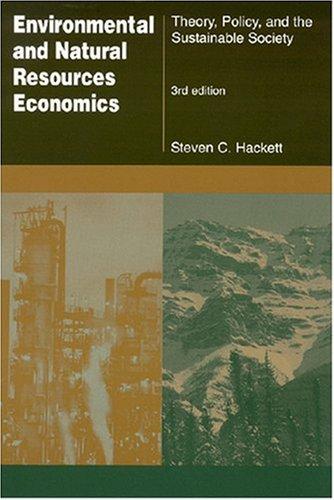7. Spreadsheet simulation (more advanced): Consider the following simplified fitted TCM linear regression equation: VISITS = 50,000
Question:
7. Spreadsheet simulation (more advanced): Consider the following simplified fitted TCM linear regression equation: VISITS = 50,000 + 0.5*INC +
50*TCSUB – 100*TCTARGET, where VISITS is the annual number of visits to the target area under study, INC = per capita personal income, TCSUB
= travel cost to a substitute destination, and TCTARGET = travel cost to the target area. Suppose that the mean value of INC is $50,000, the mean value of TCSUB is $500, and the mean value of TCTARGET is $200. Enter all this information into a spreadsheet.
a. What does the fitted TCM regression forecast as the annual number of visits to the target area when the independent variables are evaluated at their mean value?
b. Create a table with two columns, one labeled “travel cost” and one labeled “estimated number of visits.” Continue to use the mean values for INC and TCSUB in the regression equation, but now progressively increase the mean value of TCTARGET in $10 increments. This will tell us the marginal effect of an increase in the travel cost “price” on the estimated number of visits. Record (TCTARGET + $10 increment) and the associated forecast number of visits in each row of the table. Stop adding increments of $10 to the mean value of travel cost when the forecasted number of visits reaches zero.
c. Plot these data in a diagram where the “y” axis is labeled “travel cost”
and the “x” axis is labeled “estimated number of visits.” Label the curve as the “resource demand curve.” It should be downward-sloping and linear.
d. Use geometry to calculate the area under this resource demand curve and above the $200 average travel cost “price” line. This figure represents a simplified estimate of the net economic recreational use value (consumer surplus) derived from the target area. Provide a brief narrative economic interpretation of your findings. Given that the mean value of TCTARGET can be interpreted as the average actual “price” paid for the recreational experience, explain why the area under the resource demand curve represents a simplified estimate of the consumer surplus derived from recreational visitation.
Step by Step Answer:

Environmental And Natural Resources Economics Theory Policy And The Sustainable Society
ISBN: 9780765614728
3rd Edition
Authors: Margaret Ray ,David A. Anderson






